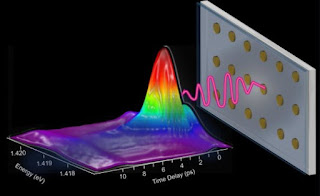Researchers have found the formation of a
quick, tuneable and stable nanoparticle-cluster
laser for moderate and effective detecting and sensing. Recent discovery
demonstrates that natural organic dye material with metallic nanostructures can
give ultrafast lasing flow with short and quickly showing up laser pulses.
Generating laser pulses rapidly can be exceptionally helpful in information
processing and can enhance the reaction of some optoelectronic devices.
The examples used as a part of the analyses
are made out of gold nano particles kept on glass and immersed in an organic,
light-radiating material. The nano-particles are organized near each other in a
square cluster. Electric
fields confined around the particles result in high field qualities that
accelerate the atomic elements in the organic dye. The electromagnetic fields
and the leading gold particles interact with each other and help it to create a
directional laser pulse that is ultra fast.
Types
of Gold nanoparticles:
- Gold nanospheres
- Gold nanorods
- Gold nanoshells
- Gold nanocages
- SERS nanoparticles
These lasers are helpful for all-optical
exchanging and detecting and will potentially enhance the speed of optical
media communications and execution of devices. Small Nano lasers don't
typically provide clearly directional beams.
Organizing nanoparticles in an exhibit extensively enhances
directionality. Estimating the properties of the pulses is extremely demanding
because of their high speed. The laser happens in optical modes that are
hybrids of light and the movement of electrons in metal. These modes are called
surface lattices resonances. The laser light is first pressed by the metallic
nanoparticles into sub-wavelength measurements, and after that it escapes from
the surface cross section reverberation modes as a picosecond-fast,
concentrated laser beat. These metal nano-particle exhibit lasers are fantastic
for producing beat laser radiation with a high adjustment speed. The pulses
created from the nano-particle-cluster laser are fast to the point that there
are no customary electronic cameras that can catch its elements. The strategy
is called pump-test spectroscopy.
Two major areas of gold nano-particle applications are material science and
bio-medicine.
Meet us at “4th International Conference on
Crystallography & Novel Materials” in Bucharest, Romania for more recent
updates on Material Science, Crystallography and Nanotechnology.
For more details, contact:
Jessica Mark
Program Manager | Crystallography Congress
2018
Tel: +1-201-380-5561
Toll No: +44-2088190774

No comments:
Post a Comment